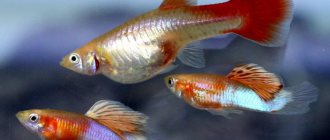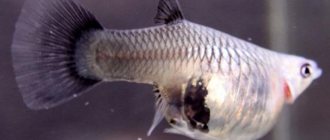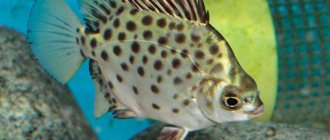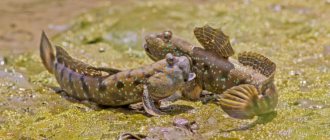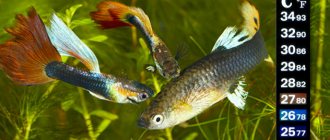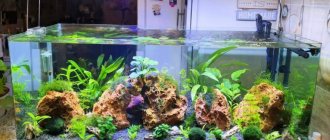Diversity in the world of viviparous fish
Guppies are a species of aquarium fish that have gained widespread recognition. They are bred by both beginning aquarists and experienced specialists. In such a matter, it is important to know the nuances, for example, to understand what temperature should be in the aquarium for guppies, how many times and what to feed these fish, whether they need an aeration system, etc. It is worth saying that guppies attract the attention of aquarists for many reasons:
- These tiny fish are easy to keep. A beginner can handle them. Many people start them without having heaters, because the temperature in a guppy aquarium can be close to room temperature.
- Being viviparous individuals, they will not construct special islands for spawning. They also do not need to be placed in a separate aquarium during spawning.
- A huge number of colors in the color of the scales and caudal fins makes guppies attractive to aquarists.
- Watching the hectic life of a small flock of guppies in your own aquarium is the highest pleasure for a true esthete.
- Guppies are kind of aquarium cleaners. Beginners are often advised to have them, because in an unsettled and not completely neglected aquarium, various unwanted inhabitants, such as white glass worms or nematodes, can appear. So, guppies can easily save an inexperienced aquarist from such a misfortune by simply eating unnecessary animals.
The role of temperature values
The role of temperature conditions is difficult to overestimate, since it affects absolutely all the inhabitants of the aquarium, plants, and even biological processes in the water.
Effect on fish
Too low indicators undermine the fish's immunity , and it becomes sensitive to many diseases.
Often hypothermia leads to the so-called semolina - ichthyophthyriasis.
This is a dangerous infection that spreads quickly and often leads to the death of aquarium inhabitants.
In the cold, most fish feel uncomfortable , they become lethargic, refuse to eat, and lose color.
Cold water is the most dangerous for the fry, since it does not grow in it, and in just a few days it becomes “dragged” - it will never be able to grow to its normal size again.
When it is too hot, aquatic organisms often experience oxygen starvation, since the warmer the water, the worse the gases dissolve in it. As a rule, fish die not from overheating, but from suffocation caused by elevated temperatures.
For plants
Most species of aquarium plants are native to the tropics, so they do not tolerate hypothermia. If the degrees are below 24°C, they slow down their growth, and if below 20°C, they die .
Overheating causes no less sad consequences.
The higher the temperature, the faster the plants consume nutrients, but at the same time, it is impossible to saturate a liquid that is too warm with carbon dioxide.
Namely, carbon dioxide is the engine of growth, so plants “eat up” the available nitrates/phosphates as long as there is at least a minimum value of CO2 in the water.
But this happens in just a few hours, then algae come into play, for the growth of which carbon dioxide is not so important. And the aquarist, instead of a beautiful underwater garden, gets something more reminiscent of a swamp.
To the biological environment
Not only fish breathe in the aquarium, but also beneficial bacteria that process all waste into safe compounds.
Since there is not enough oxygen in an environment that is too warm, some of the bacteria die and the rate of nitrification slows down. The appearance of ammonia/ammonium and nitrite in water has a poisonous effect on all hydrobionts without exception.
Ideal aquarium temperature for guppies
If we judge the survival threshold, then guppies are able to exist in conditions from 15 to 36 degrees Celsius. But for them this is rather an extreme temperature, so these indicators should not be adhered to. Otherwise, you can significantly shorten the life of the fish by killing them with neglect. Experts recommend setting the temperature within 23-27 degrees. In general, ideally the temperature in a guppy aquarium should be 24 degrees Celsius, but a slight deviation of a couple of degrees down or up will not cause significant harm to the health of the pets. By the way, the rather wide temperature range of keeping guppies in an aquarium is another reason that these fish are the most popular in pet stores. You can safely add them to more heat-loving fish or to cold-loving ones.
Experts recommend, if necessary, increasing or decreasing the temperature in the guppy aquarium on a gradual basis. A sharp drop can harm the health of the fish. During spawning, the temperature can be slightly increased, because at first the fry need more gentle conditions for proper and rapid development than mature adults.
Breeding at home: how to distinguish a female and when to breed
Adding sea salt to the water at the rate of 2 g per 1 liter of water has a positive effect on the breeding and well-being of guppies. You can also add iodine - 1 drop of 5% solution per 10 liters. Sea salt can be replaced with table salt, provided it is coarsely ground.
Important! Guppy lives and breeds normally in a community aquarium, provided that there are no aggressive fish in the neighbors. Reproduction begins at 3–4 months.
The body shape of the fish is flattened on the sides, it is elongated in length. The guppy itself is small.
Females and males differ markedly from each other in color, shape and size due to pronounced sexual differences:
- Females grow from 3 to 7 cm , they are easy to distinguish from the male, they have an enlarged abdominal part, and eggs are located in the anus. The color can be yellow-gray, gray-blue or grayish-olive. Small fins of a pale yellow hue, rarely pink or blue.
- The males have long fins and an unusually beautiful painted tail. The body length is only 2 - 4 cm. The color can be rich gold, green, blue, red, black or yellow. Males have an anal fin - this is a special fertilization organ with which they mate.
Guppies usually swim on the surface of the water , they have a peaceful nature, calm fish, so they can suffer from more aggressive neighbors.
If we talk about how long they live, then the average duration is 3 years.
Content
In addition to the question discussed above about what the water temperature should be for guppies in an aquarium, there are a number of other rules for their successful maintenance. When it comes to proper nutrition, experts advise alternating dry food and frozen food; both options can be found without problems in pet stores. Guppies love daphnia, coretra and cyclops. The fish will not refuse bloodworms either. Experts recommend sprinkling a pinch of food once a day, maybe twice, but little by little. Fish should not be overfed. In addition, the quality of the feed plays a crucial role. If you buy it for a month at once, then it is better to freeze the “live” food. Obviously, the questions about what temperature is needed in the aquarium for guppies and what to feed the fish are the main ones in the content, but there are other important nuances.
Signs of overeating
To avoid undesirable consequences, you need to feed the guppies correctly, based on the size of the fish and the weight of the food. The weight of food in the first days of life should exceed the parameters of the fish by 60–70%. After 8–10 weeks, food exceeds body weight by only 30%.
When initial symptoms of overeating appear, it is recommended to reduce the amount of food to 7–10%, reduce the caloric content of food, and then arrange a fasting day:
- if the pet’s abdominal cavity has noticeably increased in size;
- a string of feces trails from the guppies.
Facts about caring for fry
Sooner or later the guppies will give birth. When this happens, you should take care of the young animals. It is better to separate the fry from the adults. For these purposes, a container of 20 liters may be quite suitable. But there is another acceptable option: divide the aquarium with a fine mesh net. This way the fry will be able to penetrate through her holes, swimming away from the mother, who can eat them. The optimal temperature in the aquarium for young guppies is no different from that recommended for adults. Of course, for the first days of life it is better to maintain a temperature of 27 degrees Celsius, gradually reducing it to 24.
How many degrees should it be?
For each type of fish, it is necessary to maintain a different temperature regime; this should be taken into account when selecting residents of the aquarium.
The most common types of fish prefer the following temperatures:
| Type of fish | Optimal temperature, °C | Permissible temperature, °C |
| Viviparous fish (guppies, mollies, platies, swordtails) | 24-25 | 22-27 |
| Carptooths (barbs, cardinals, rasboras) | 24-26 | 24-26 |
| Small characin fish (neons, tetras, hassemanias, minors) | 24-26 | 23-27 |
| Discus | 29-30 | 28-32 |
| Goldfish | 20-22 | 18-23 |
| Catfish | 22-24 | 20-25 |
| African cichlids (Malawians, Julidochromis) | 25-26 | 24-28 |
| American cichlids (angelfish, cichlozomas) | 24-25 | 24-26 |
The table shows the parameters for adult fish; for fry and adolescents, the optimal temperature is always 1-2°C higher.
The situation is the same with plants, many of them cannot tolerate warm water, many cannot tolerate hypothermia:
| Plant | Optimal temperature, °C | Permissible temperature, °C |
| Rotala | 25 | 24-27 |
| Nayas | 22 | 20-26 |
| Hornwort | 22 | 18-28 |
| Nympheas | 25 | 24-27 |
| Ludwigia | 24 | 23-26 |
| Hygrovils | 25 | 24-27 |
| Anubias | 24 | 22-26 |
| Bucephalandra | 25 | 22-26 |
| Mosses | 22 | 20-26 |
| key moss | 18-20 | 14-21 |
| Cryptocorynes | 24 | 24-27 |
For most aquarium plants, the optimal temperature is 24-26°C.
If sea
In a marine aquarium, as well as in a fresh one, the optimal values are 24-26°C.
In warmer water, stony corals begin to experience calcium starvation, which prevents skeletal building. In cool conditions, development slows down significantly.
Soft corals can withstand temperatures from 23° to 29°, hard corals 24-27°C.
The greatest danger is elevated temperature for fish, because just like in a freshwater vessel, oxygen does not dissolve well in a warm environment, and the fish suffocate.
Changing water in an aquarium with fry
Experienced aquarists recommend changing up to 40% of the water every day in an aquarium with young guppies. Under normal conditions of life, when all the fish are mature and strong, this procedure is carried out once a week or as the aquarium becomes dirty. In all cases, the water being poured must be settled and have a temperature as close as possible to the temperature in the guppy fish aquarium to avoid unnecessary stress for the pets. The filter sponge must be washed as needed if its model is installed inside an aquarium. If an external modification is used, then the cleaning procedure will be carried out quite rarely (sometimes once every six months). As for the aeration of water in a guppy aquarium, it will never be superfluous, because additional saturation of tap water with oxygen is a big step towards the health and longevity of the fish.
As you can see, keeping guppies is not at all difficult. It is only important to choose the right conditions for them, and then the natural corner in the house will delight and bring aesthetic pleasure.
How to measure indicators?
There are several ways to determine the temperature of aquarium water: using a thermometer, an indicator strip, and focusing on the water heater.
Thermometer
Several types of thermometer are used in aquarium keeping, each of them has its own advantages and disadvantages:
- Alcoholic. The most accurate, but since it is made of glass, it is easy to break.
- Electronic (internal). Also quite accurate, but expensive.
- Electronic (remote). Only the sensor is placed in the water; the digital display remains outside the aquarium. It has a high degree of error.
Alcohol thermometers are the most popular due to their optimal price/quality ratio.
Heater
Modern aquarium heaters are equipped with a sensor. When the device is working, the light is on, when it heats the water to the set temperature, it turns off and the light goes out.
You should not seriously consider this method, since the heater may fail at any moment, it may jam, or it may not work entirely correctly.
indicator strip
This is a crystal thermometer that is glued to the glass of the aquarium.
Depending on the temperature, a certain area on the strip begins to color , the inscription on which corresponds to the temperature of the reservoir.
This strip looks quite aesthetically pleasing, but the accuracy of its readings leaves much to be desired.
Normalizing the temperature
To make the aquarium inhabitants and plants comfortable, it is enough to set the temperature once.
All you need is to buy a heater, but you should approach its choice carefully:
Particularly cheap Chinese models are of low quality and quickly break down.
It’s good if such a device simply turns off and the fish sit in cold water for a while, but it happens that the heater jams and it does not turn off, turning the aquarium into a fish soup.- It is important to pay attention to the thermostat step. Some models have a step of 2-3°, this is unacceptable. The step should not exceed one degree.
- Power is the most important nuance when choosing a heater. A 25W device simply cannot heat a 100-liter aquarium. There is a golden rule - 1 W per 1 liter. (A 50-liter aquarium needs a 50W heater, a 200-liter aquarium needs a 200W heater).
- Suckers. This point does not affect performance, but sometimes you can find heaters on sale with suction cups that are so “oaky” that the device does not stick to the glass. The suction cups should be soft and easily creased in your hands.
- It is imperative to have an LED indicator - this allows you to understand whether the device is working.
The best proven heaters are Tetra, Aquael, Eheim, and Juwel.
After the heater has been purchased, it must be installed. It is best to attach it to the glass where the filter (or the outlet of the external filter) is located so that the warm water is carried by the current.
The device must be completely submerged under water, but some models allow you to leave the regulator on the surface. No matter how high-quality the aquarium heater is, its operation should definitely be monitored using an ordinary alcohol thermometer.
It is better to place the thermometer as far as possible from the device, then its readings will be most accurate.
When keeping demanding fish that require a certain temperature, it is worth installing 2 heaters.
If one device fails, the second will continue to work. This is true for marine aquariums, discus fish, and demanding species of expensive cichlids.
Habitat
Guppies were first discovered in South America, more precisely in its northern part. The natural range is not so small: these fish are found on the islands of Trinidad and Tobago, Venezuela and Brazil, their populations occupy a significant part of the Amazon River basin. The homeland of guppies is characterized by a hot and humid climate, as well as a large number of fresh rivers. Fish prefer river and lake water, but easily adapt to cold high-mountain streams. They live in swamps and in muddy artificial canals, but not in sea water.
This is interesting! It is noteworthy that the diet of wild guppies includes the larvae of malaria mosquitoes. To combat these insects, small fish were distributed throughout warm water bodies around the world.

